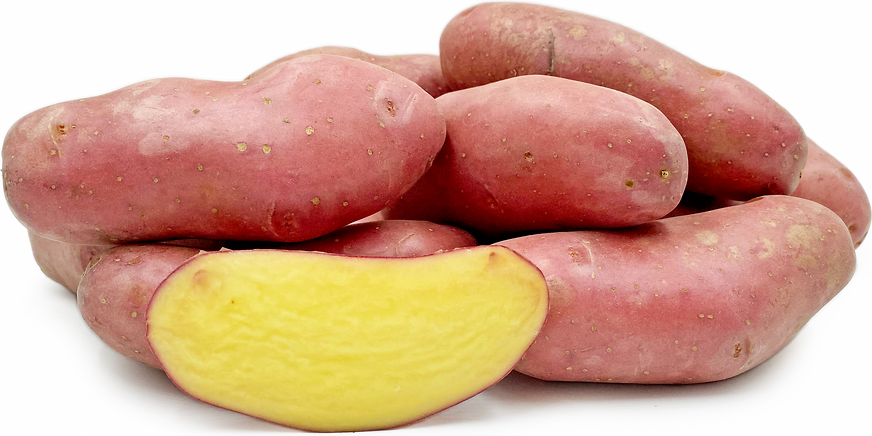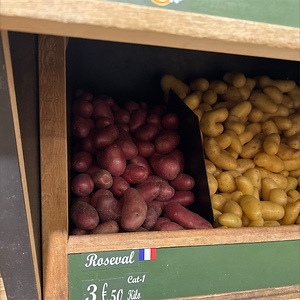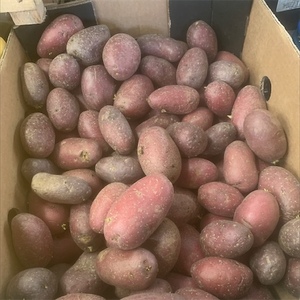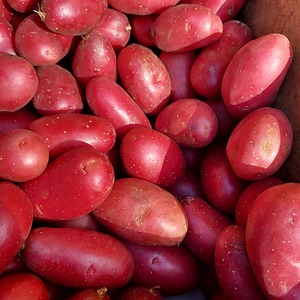


Roseval Potatoes
Estimated Inventory, lb : 0
Description/Taste
Roseval potatoes are small, uniform tubers with an elongated, oval, and slightly flattened shape. The skin is thin, smooth, and dark red with a few, shallow eyes and light brown spots scattered across the surface. Underneath the skin, the flesh is high in moisture, low in starch, and generally solid yellow, sometimes exhibiting faint, pink-red veins depending on growing conditions. When cooked, Roseval potatoes have a soft, creamy, and dense consistency with a sweet, nutty, and earthy taste.
Seasons/Availability
Roseval potatoes are available year-round, with a peak season in the late spring through early summer.
Current Facts
Roseval potatoes, botanically classified as Solanum tuberosum, are an early maincrop variety that belongs to the Solanaceae or nightshade family. The small tubers were developed in France for their unique size, flavor, and appearance, and within local markets, the tubers are also sold under the name French Fingerling. Roseval potatoes are highly favored by chefs as a culinary potato and are found in both markets and home gardens across France. The variety is used in a wide array of applications and is also valued for its high yields, rich flavor, and bright red skin. Outside of France, Roseval potatoes are challenging to find and are considered a specialty variety, especially in the United Kingdom and the United States.
Nutritional Value
Roseval potatoes are a good source of vitamin C, which is an antioxidant that can help boost the immune system and increase collagen production within the body. The tubers also contain riboflavin, thiamine, vitamin B6, and iron, and provide trace amounts of calcium, phosphorus, and zinc.
Applications
Roseval potatoes are best suited for cooked applications such as roasting, baking, boiling, and steaming. The small tuber has a neutral flavor, making it widely versatile in savory applications, and the red skin does not lose its coloring when cooked. The skin is also thin and edible, and the flesh holds its shape well, shortening the preparation time during cooking. Roseval potatoes can be roasted whole or halved with fresh herbs and spices, sliced and layered into casseroles, cubed and boiled for salads, tossed into soups and stews, or browned in a skillet and then slow braised in broth to finish. The tubers can also be steamed and coated in flavored vinegar or oils, roasted with peppers as a savory side dish, or wrapped in foil and cooked on a grill with various meats. Roseval potatoes pair well with yellow peppers, herbs such as rosemary, thyme, sage, oregano, parsley, and cilantro, garlic, shallots, chives, tomatoes, carrots, squash, kale, eggplant, fennel, leeks, pumpkin seeds, and tofu. The tubers will keep 3-5 weeks when stored whole and unwashed in a cool and dark place.
Ethnic/Cultural Info
In France, fingerling potatoes were initially met with great resistance. Many French citizens believed the tubers were poisonous and caused disease, leading the French parliament to even ban potato cultivation in 1748. While potatoes became a source of gossip in the French markets, Antoine-Augustin Parmentier, a French pharmacist, discovered that the tubers were not harmful and began studying the plants to change the potato’s reputation. With his research, Parmentier convinced parliament to repeal the ban in 1772 and began focusing on the public’s perception of the tuber. Legend has it that Parmentier centered many dinner parties around the use of the potato with high profile attendees to encourage wealthy families to consume the tubers. Parmentier also had King Louis XVI construct a potato garden that was surrounded by armed guards to create a sense of demand. Using the strategy of exclusivity, Parmentier instructed the guards to pretend to protect the garden, but also allow thieves to steal the tubers for resale in public markets. The stolen potatoes soon became a highly desired cooking ingredient, which led to potatoes becoming a staple in French cuisine.
Geography/History
Roseval potatoes were developed commercially in France in the mid-20th century. The tubers were created from a cross between parent varieties rosa and vale potatoes and were released by SICA Bretagne Plants, which is an organization that connects potato growers, breeders, and distributors for commercial trade. After its release, Roseval potatoes became a popular culinary variety in France for its unique size and ease of preparation. Roseval potatoes then spread across Europe to the United Kingdom in the 1950s and were also introduced to the United States, where they were slow to adapt to the market. Eventually, fingerling potatoes became a valued commodity in the American food scene, and today, Roseval potatoes are considered a specialty cultivar found through select grocers and farmer’s markets throughout Europe and the United States.
Recipe Ideas
Recipes that include Roseval Potatoes. One
| Oh My Dish |
|
Venison with Roseval Potatoes and Pumpkin |
| Health and Harmonize |
|
Rosemary Chicken with Roseval Potatoes |










